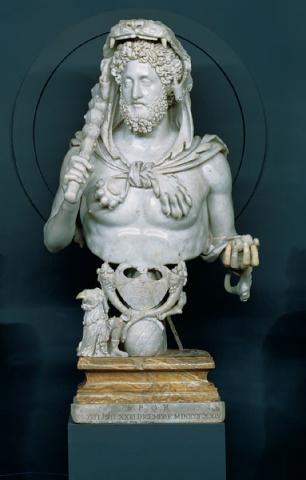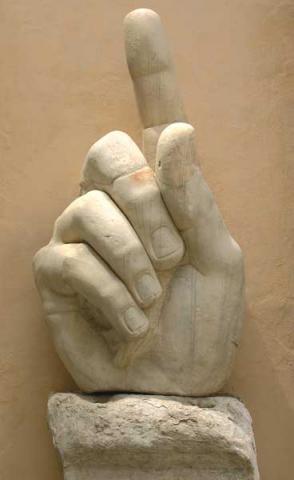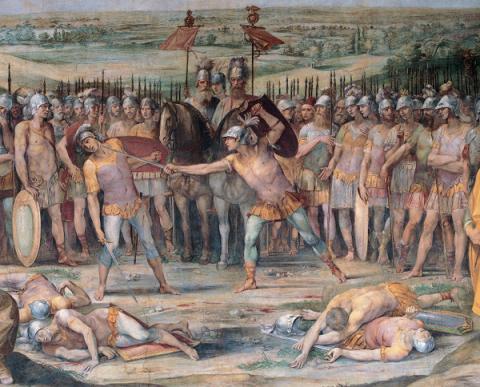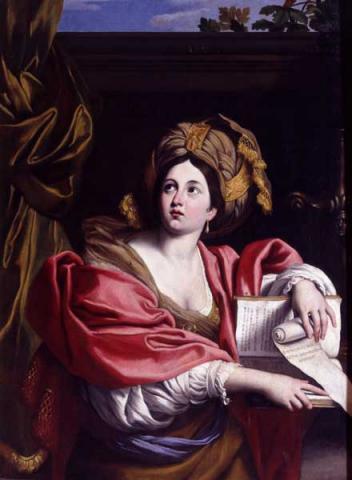Palazzo Nuovo
In the rooms at the Palazzo Nuovo, the touch book "Palazzo Nuovo. I capolavori di scultura antica" *, allowing blind and visually impaired visitors to get to know ten of the most important masterpieces.
Inside the book and on site (on the ground and first floors) there is also a relief map showing the places and works represented.
* "Palazzo Nuovo. I capolavori di scultura antica" edited by Marina Mattei, Ivelise Schiavoncini, Giuseppina Simili, Maria Poscolieri. Turin 2004
Ground floor
On the ground floor of Palazzo Nuovo, the courtyard leads to the Egyptian Room, where the Capitoline Museums' collection of Egyptian and Egyptian sculptures is exhibited, most of them coming from the Temple of Isis in Campo Marzio. Knowledge of these works is possible thanks to some in-depth information sheets in italian produced as part of the National Civil Service project "Musei Capitolini a portata di mano" (2020-2021).

La Sala Egizia Capitolina
Statua del Faraone Ramesses secondo
Cinocefali Capitolini
Sfinge del Faraone Amasis Secondo
Statua di Coccodrillo
First floor
At the first floor, the visit is further supported by three relief panels dedicated to specific works, as well as by a series of fact sheets in italian produced thanks to the cooperation of volunteers from the Servizio Civile project (2017-2018).
PALAZZO NUOVO - FIRST FLOOR - TOUCH BOOK ROUTE
[click the map to enlarge]
I - Gallery: the touch book contains a short description and a relief drawing of the work known as The Drunken Old Woman.
III - The Venus Cabinet: for the room displaying the famous Capitoline Venus, a brief description and a relief drawing are available in the tactile book. The same drawing is available on a relief panel in Braille near the work.

IV - Hall of the Emperors: The tactile book contains a description in italiana and a relief drawing of the portrait of the Emperor Caracalla. It is possible to learn about some of the works on display thanks to the relevant in-depth information sheets in italian.

Statua seduta di Elena - Listen to the Audio description in Italian (.mp3)
Ritratto di Giulia Domna, moglie dell’imperatore Settimio Severo
Ritratto di Giulia Mameo, madre dell’imperatore Alessandro Severo
Ritratto di giovane donna
Ritratto di dama di età tardo-flavia
V - Hall of the Philosophers: inside the tactile book there is a descriptive card in italian and a relief drawing of the portrait of the philosopher Pythagoras.
VI - Hall: In addition to the descriptive cards in italian and relief drawings depicting the two famous Centaurs, the Old Centaur and the Young Centaur, inside the tactile book, in the hall there are two educational relief panels.

VII - Hall of the Faun: for this room there are available, inside the tactile book, two descriptive cards in italian and two relief drawings, one concerning the Sarcophagus with the myth of Selene and Endymion and another one concerning the statue of the Boy choking the goose. A downloadable version of the latter work is also available with an in-depth educational sheet in italian.

Il fanciullo che strozza l’oca
VIII - Sala del Galata: for the visit to the room that houses the famous sculpture of the dying Galata, the blind visitor has at his disposal descriptive cards in Italian accompanied by relief drawings inside the tactile book, one dedicated to the statue of Cupid and Psyche, the other to the Galata. There is also a didactic card in italian for the latter famous work.



















































